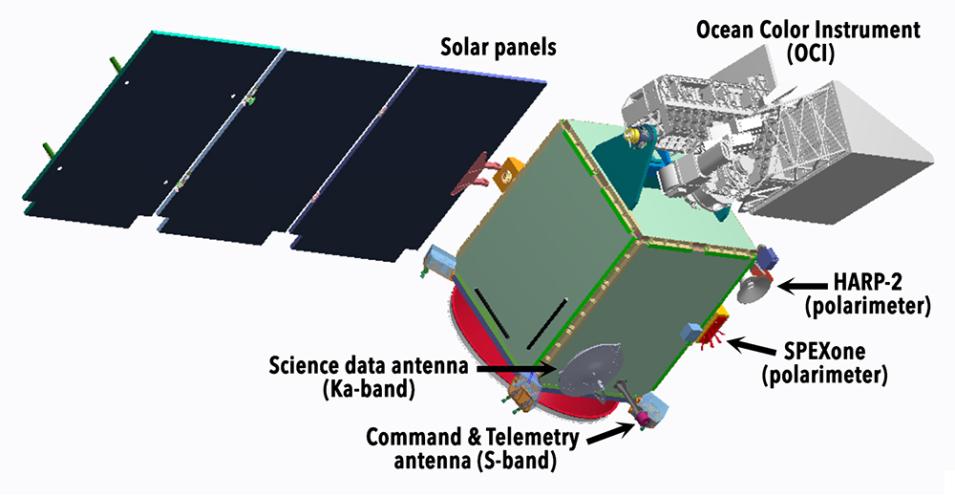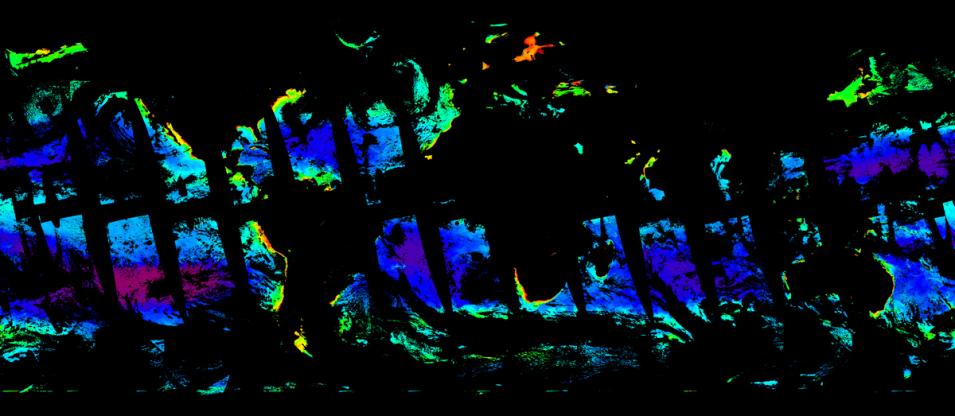When NASA's Plankton, Aerosol, Cloud, ocean Ecosystem (PACE) satellite launched into space on February 8, 2024, the team was excited for the spacecraft to begin its mission. This is not only because the endeavor was more than a decade in the making and critical for understanding Earth's ocean, atmosphere, and climate. The team was also ready for launch knowing they had expertly prepared themselves by using simulated data to test and practice using PACE's sensors and data systems to ensure that global data users would get the quality science data they need.
"The simulated data provided confidence to our group and proved that we could successfully push bits through the science data processing system while also carefully identifying any gaps and issues to resolve," said PACE Project Scientist Dr. Jeremy Werdell. "The data in combination with other tools showed us we can expect PACE's instruments to perform extremely well."
PACE is equipped with three sensors. The Spectro-Polarimeter for Planetary Exploration (SPEXone) and the Hyper Angular Research Polarimeter (HARP2) are aboard to study clouds and aerosols. PACE's primary sensor is the Ocean Color Instrument (OCI), which is a highly advanced optical spectrometer that measures light reflected by the ocean. And ocean color is a key element of assessing ocean health.
Microscopic algae called phytoplankton make up a tremendous amount of ocean biomass. Phytoplankton and their plumes can change the wavelengths of light absorbed or reflected by water and, through this, ocean color. Precisely measuring the ocean color and tracking plumes of phytoplankton will aid scientists in understanding ocean ecology and provide essential information for climate studies.
The OCI can measure the color reflected by the ocean and other properties of ultraviolet to infrared light across nearly 300 wavelengths, providing greater detail than any previous ocean color mission. PACE will complete surveys of the entire globe every two days and provide data and imagery at a resolution of 1.2 km (0.75 miles).
Given the advanced and complex nature of the OCI, NASA needed realistic data to simulate using it ahead of launch.
Why Use Simulated Data?
Before a satellite mission begins, scientists and others need data to test, trial, estimate, or simulate how sensors and systems will produce data and products. Sometimes they can use what's known as proxy data, which are data from another source or satellite similar to what the new instrument will output.
"Early on we used data from the Airborne Visible/Infrared Imaging and Portable Remote Imaging Spectrometers as proxies for OCI, but quickly realized we needed something more," said Sean Bailey, manager of NASA's Ocean Biology Distributed Active Archive Center (OB.DAAC). OB.DAAC archives and distributes NASA ocean color data, and will be the home for PACE data.
That something more were simulated data, which are data generated to exactly match the format of the data produced by the sensor being used, such as the OCI.
"Simulated data could simply be a test pattern or even just constant values written into the expected data format to test the code and production mechanics of a data system," said Bailey. "What is even better is to simulate geophysically realistic data, which can not only test the mechanics of the code, but also, to an extent, test the validity of the processing algorithms."
Putting OCI Through its Paces
For PACE's OCI, NASA's Ocean Biology Processing Group developed a program called the Python Top of Atmosphere Simulation Tool (PyTOAST) to produce simulated Level 1B data. The data precisely mimic OCI sensor data, account for atmospheric effects on reflected light, and allow the team to mechanically test both the processing system code and detection algorithms. PyTOAST incorporates products and data from the Moderate Resolution Imaging Spectroradiometer (MODIS); the Visible Infrared Imaging Radiometer Suite (VIIRS); the Modern-Era Retrospective analysis for Research and Applications, Version 2 (MERRA-2); and other sources to produce radiometric data just like what PACE will record in space.

